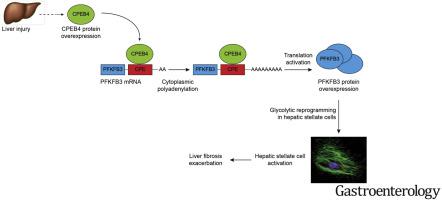Gastroenterology ( IF 29.4 ) Pub Date : 2020-03-10 , DOI: 10.1053/j.gastro.2020.03.008 Marc Mejias 1 , Javier Gallego 1 , Salvador Naranjo-Suarez 2 , Marta Ramirez 2 , Nuria Pell 2 , Anna Manzano 3 , Clara Suñer 4 , Ramon Bartrons 3 , Raul Mendez 5 , Mercedes Fernandez 1

|
Background & Aims
We investigated mechanisms of hepatic stellate cell (HSC) activation, which contributes to liver fibrogenesis. We aimed to determine whether activated HSCs increase glycolysis, which is regulated by 6-phosphofructo-2-kinase/fructose-2,6-bisphosphatase-3 (PFKFB3), and whether this pathway might serve as a therapeutic target.
Methods
We performed studies with primary mouse HSCs, human LX2 HSCs, human cirrhotic liver tissues, rats and mice with liver fibrosis (due to bile duct ligation [BDL] or administration of carbon tetrachloride), and CPEB4-knockout mice. Glycolysis was inhibited in cells and mice by administration of a small molecule antagonist of PFKFB3 (3-[3-pyridinyl]-1-[4-pyridinyl]-2-propen-1-one [3PO]). Cells were transfected with small interfering RNAs that knock down PFKFB3 or CPEB4.
Results
Up-regulation of PFKFB3 protein and increased glycolysis were early and sustained events during HSC activation and accompanied by increased expression of markers of fibrogenesis; incubation of HSCs with 3PO or knockdown of PFKFB3 reduced their activation and proliferation. Mice with liver fibrosis after BDL had increased hepatic PFKFB3; injection of 3PO immediately after the surgery prevented HSC activation and reduced the severity of liver fibrosis compared with mice given vehicle. Levels of PFKFB3 protein were increased in fibrotic liver tissues from patients compared with non-fibrotic liver. Up-regulation of PFKFB3 in activated HSCs did not occur via increased transcription, but instead via binding of CPEB4 to cytoplasmic polyadenylation elements within the 3'-untranslated regions of PFKFB3 messenger RNA. Knockdown of CPEB4 in LX2 HSCs prevented PFKFB3 overexpression and cell activation. Livers from CPEB4-knockout had decreased PFKFB3 and fibrosis after BDL or administration of carbon tetrachloride compared with wild-type mice.
Conclusions
Fibrotic liver tissues from patients and rodents (mice and rats) have increased levels of PFKFB3 and glycolysis, which are essential for activation of HSCs. Increased expression of PFKFB3 is mediated by binding of CPEB4 to its untranslated messenger RNA. Inhibition or knockdown of CPEB4 or PFKFB3 prevents HSC activation and fibrogenesis in livers of mice.
中文翻译:

CPEB4增加PFKFB3的表达以诱导糖酵解并激活小鼠和人类肝星状细胞,从而促进肝纤维化。
背景与目标
我们调查了肝星状细胞(HSC)激活的机制,这有助于肝脏纤维化。我们旨在确定活化的HSC是否增加糖酵解(由6-磷酸果糖-2-激酶/果糖-2,6-双磷酸酶-3(PFKFB3)调节),以及该途径是否可以作为治疗靶标。
方法
我们对原代小鼠HSC,人LX2 HSC,人肝硬化肝组织,患有肝纤维化(由于胆管结扎[BDL]或施用四氯化碳的大鼠和小鼠)和CPEB4敲除小鼠进行了研究。通过给予PFKFB3小分子拮抗剂(3- [3-吡啶基] -1- [4-吡啶基] -2-丙烯-1-酮[3PO]),糖酵解作用在细胞和小鼠中得到抑制。细胞被敲低PFKFB3或CPEB4的小干扰RNA转染。
结果
PFKFB3蛋白的上调和糖酵解的增加是HSC激活过程中的早期和持续事件,并伴随着纤维化标志物的表达增加。用3PO孵育HSC或敲除PFKFB3可降低其活化和增殖。BDL后患有肝纤维化的小鼠肝脏PFKFB3增加;与给予媒介物的小鼠相比,手术后立即注射3PO可防止HSC活化并降低肝纤维化的严重程度。与非纤维化肝脏相比,患者的纤维化肝脏组织中PFKFB3蛋白水平升高。活化的HSC中PFKFB3的上调不是通过增加转录发生的,而是通过CPEB4与PFKFB3信使RNA的3'非翻译区域内的细胞质聚腺苷酸化元件的结合而发生的。敲低LX2 HSC中的CPEB4可防止PFKFB3过表达和细胞活化。与野生型小鼠相比,BDL或施用四氯化碳后,来自CPEB4-敲除的肝脏的PFKFB3减少和纤维化。
结论
来自患者和啮齿动物(小鼠和大鼠)的肝纤维化组织中PFKFB3和糖酵解的水平增加,这对于激活HSCs至关重要。PFKFB3的表达增加是由CPEB4与其未翻译的信使RNA结合而介导的。CPEB4或PFKFB3的抑制或抑制可防止小鼠肝脏中的HSC活化和纤维化。


























 京公网安备 11010802027423号
京公网安备 11010802027423号